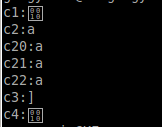70,037
社区成员
 发帖
发帖 与我相关
与我相关 我的任务
我的任务 分享
分享
void main()
{
char c1 = {'\x10'};
printf("c1:%c\n", c1);
char c2 = {'xa'};
printf("c2:%c\n", c2);
char c20 = 'xa';
printf("c20:%c\n", c20);
char c21 = {'0xa'};
printf("c21:%c\n", c21);
char c22 = {'a'};
printf("c22:%c\n", c22);
char c3 = {'\x8'};
printf("c3:[%c]\n", c3);
char c4 = {'\x10', 'xa', '\x8'};
printf("c4:%c\n", c4);
}
